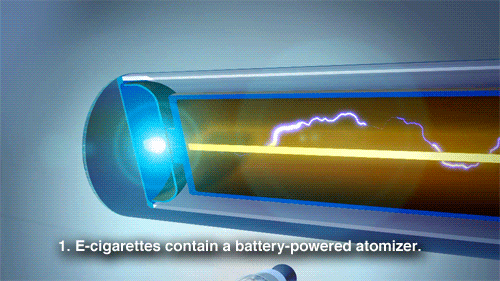7 things you need to know about electronic cigarettes
On this week’s “TechKnow,” contributor and molecular neuroscientist Crystal Dilworth explores the world of electronic cigarettes, from an e-cig convention in Anaheim, Calif., to a research lab at the University of California in San Francisco.
Here’s what you need to know about e-cigarettes:
1. Where did they come from?
Herbert A. Gilbert patented a “smokeless, non-tobacco cigarette” in 1963, but the invention of the modern electronic cigarette can be traced to Chinese pharmacist Hon Lik.
Motivated by his own smoking habit and his father’s death from lung cancer, Hon developed and patented the first e-cigarette in 2003 and his company began marketing them in China and abroad the next year.

A small lithium battery inside an e-cigarette’s customizable module, or “mod,” powers an atomizer, which heats up a liquid solution (usually nicotine dissolved in propylene glycol plus flavoring and colors). The solution turns into vapor, which is inhaled and exhaled like smoke. The solutions, called “juices” because of the different fruity flavors available, can have nicotine concentrations from 0mg to 26mg.
3. Are they healthier than regular cigarettes?
E-cigarettes do not burn, so there is no combustion to produce the harmful carcinogens that traditional cigarettes give off. This has led many to believe that they are healthier than traditional cigarettes. However, there have been few studies conducted on the nicotine solution used in e-cigs. There may be fewer carcinogens, Dilworth says, but e-cigs still contain nicotine and other ingredients that could be toxic when vaporized.
Suzaynn Schick, a professor and researcher at UC San Francisco, has similar concerns about this nicotine solution. She is studying what she calls “third-hand” smoke, or what happens to the nicotine in e-cigarettes once exhaled by a “vaper.”
“I know that when you release nicotine into the room and it settles on a surface, it reacts with normal gases in the air to form carcinogens,” says Schick. Her research is focused on the potential health consequences that e-cigarette vapor could have on non-users.
4. Who’s smoking them?
The act of smoking an e-cigarette is referred to as “vaping,” and as Dilworth found out at the convention, “vapers” can be of all ages and backgrounds.
“I am never going back to cigarettes,” says vaper Karon Lee. “I smoked for 55 years and I got mad. I didn’t like what it cost. I bought a kit in February of 2011 and I haven’t had a cigarette since the day I got it... I think it’s the best thing you can do for yourself if you smoke.”
5. What’s the appeal?
Celebrities have jumped on board the “vaping” train with endorsements from Jenny McCarthy, Stephen Dorff, and Katherine Heigl.
Apart from the current freedom to “vape” in public non-smoking areas, e-cigarettes appeal to many because of their affordability and the ability to customize the “vaping” experience.
“With smoking, you have two basic flavors,” one e-cig convention goer tells Dilworth. “It’s tobacco or menthol. With this, some days you feel like you’re in a sour apple mood, other days you feel like you’re in a lemon mood.”
With e-cigs’ reusable mod, users can also customize the voltage of the internal battery, the concentration of nicotine in the flavored “juice,” the amount of draw, the temperature of the hit, and the metals used inside their e-cig.
6. What’s the problem?
“I don’t want to see people galloping to assume that this is the solution to the problem of smoking before they know its health effects and its public health effects,” says Suzaynn Schick, professor and researcher at the University of California in San Francisco.
Schick is running an FDA-funded study on how e-cigarettes affect the cardiovascular system. She uses a laser photometer to measure the mass of particles that are in the vapor emitted by e-cigarettes.
“The reason I care about particles is that breathing particles causes cardiovascular disease, causes people to die of heart attacks, plain and simple,” says Schick.
Dilworth got a first-hand look at the particles in e-cig smoke, when the vapor from the patrons and booths triggered the smoke detectors at the convention center in Anaheim.
“If it is just water vapor, why did it set off the fire alarm?” she asks.
There is also worry that the bright colors and fruity flavors used to market e-cigarettes will attract children, who will use them to transition to traditional cigarettes.
“We’re basically the Yogurtland of e-juice,” says one convention worker as he offers Crystal a sample of pizza-scented juice.
7. What’s next?
There is currently no regulation on the manufacture, sale, or marketing on e-cigarettes or any related products. This means that there is no regulation on the amount of nicotine that can be in different “juices” that vapers purchase. However, as U.S. sales are estimated to hit $1.7 billion this year, many expect harsher regulations to begin soon.
“You have the choice right now to go and buy some nicotine online and mix your own juice,” says Tony Borriboonratana, COO of Vape Revolution. But, he admits, “The FDA is going to regulate—and we’re prepared for that.”
Not every “vaper” is so passive about the potential regulations.
“I think they stink,” says Lee. “They’re going to drive people right back to cigarettes that are already vaping and living a healthier lifestyle.”
Watch "TechKnow," Sunday 7:30ET/4:30PT for more on e-cigarette culture and the health concerns surrounding smoking alternatives.
Error
Sorry, your comment was not saved due to a technical problem. Please try again later or using a different browser.